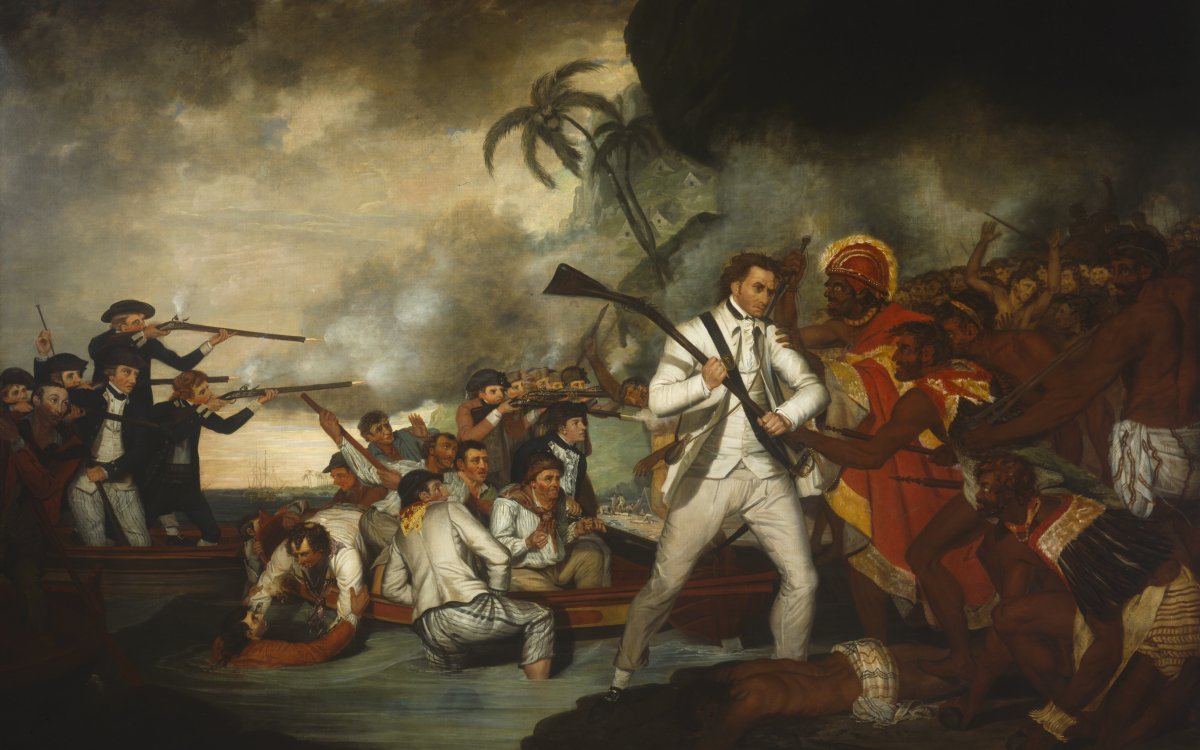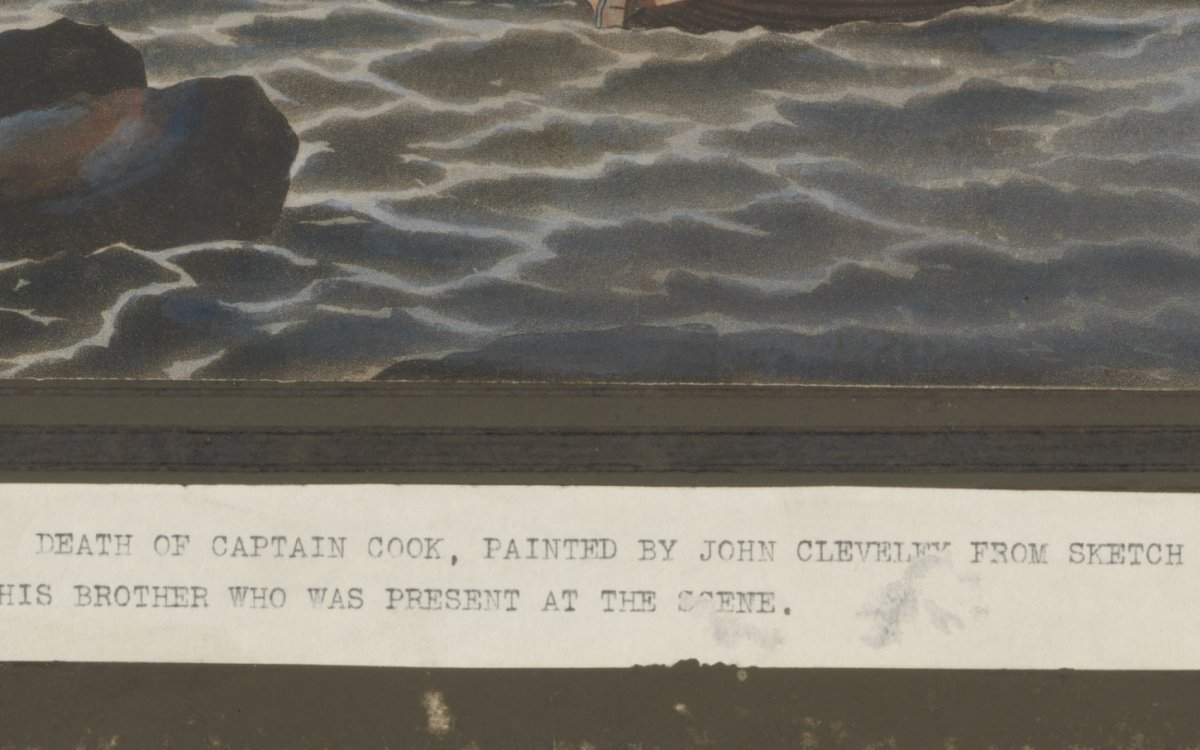
Carter, George, 1737-1795. (1781). Death of Captain Cook [picture] / G. Carter. https://nla.gov.au/nla.obj-134286967
Within the Treasures Gallery in the National Library of Australia in Canberra hangs a large oil painting in a gilded frame. The artwork was painted in 1781 by British artist George Carter (1737–1795). It is titled Death of Captain Cook. Captain James Cook was killed at Kealakekua Bay, in what is Hawaii today, on 14 February, 1779. Within the Library’s collection are many examples of images, drawings and paintings depicting this same event. Each image is unique with subtle differences to their depiction of the event.
Cook’s death at Hawaii occurred during his third circumnavigation of the Earth. Leading up to the events depicted, Cook and his men had been on the island for a month after investigating the Bering Strait. He was initially received and treated with great honour by the people. After his departure, he was quickly forced to return due to harsh weather, which had damaged his ship. This return was not met with the same enthusiasm as his first arrival.
Tensions between the Hawaiians and British grew while Cook and his men made repairs on the island. Thefts and scuffles grew more frequent and, on 13 February, one of the small boats from the British ship was stolen. In retaliation, Cook “invited” King Kalaniʻōpuʻu onboard his ship, the HMS Resolution, with the plan to hold him hostage until the boat was returned. The crowd, including the King’s wife, pleaded with him not to go – and quickly grew angry. When news reached the crowd that the British had shot and killed another chieftain in another part of the island, violence broke out.
Accounts of Cook’s death agree on many aspects but are at cross-purposes on others. Most describe the death of Cook occurring after being clubbed by a local chieftain, stabbed in the shoulder and/or being clubbed and stabbed by multiple people after falling in the water or because of a combination of these methods.
Cook’s death at Hawaii occurred during his third circumnavigation of the Earth. Leading up to the events depicted, Cook and his men had been on the island for a month after investigating the Bering Strait. He was initially received and treated with great honour by the people. After his departure, he was quickly forced to return due to harsh weather, which had damaged his ship. This return was not met with the same enthusiasm as his first arrival.
Tensions between the Hawaiians and British grew while Cook and his men made repairs on the island. Thefts and scuffles grew more frequent and, on 13 February, one of the small boats from the British ship was stolen. In retaliation, Cook “invited” King Kalaniʻōpuʻu onboard his ship, the HMS Resolution, with the plan to hold him hostage until the boat was returned. The crowd, including the King’s wife, pleaded with him not to go – and quickly grew angry. When news reached the crowd that the British had shot and killed another chieftain in another part of the island, violence broke out.
Accounts of Cook’s death agree on many aspects but are at cross-purposes on others. Most describe the death of Cook occurring after being clubbed by a local chieftain, stabbed in the shoulder and/or being clubbed and stabbed by multiple people after falling in the water or because of a combination of these methods.
Investigate Death of Captain Cook by George Carter by considering the following:
- Who made this?
- Why was it made?
- When was this made? What else was happening at this time?
- Where does this information come from?
- What’s being left out?
- How could this be interpreted differently by different people?
- What action/reaction does the creator want from me?
- Is this event depicted anywhere else?
- What artistic techniques are being using to influence my thinking?
- How does the use of colour impact my feelings, how is the image arranged, etc?
- How does the way it is presented to me impact the message of the work?

Page 27 from (1779). Account of the death of James Cook, 1779 [manuscript]. http://nla.gov.au/nla.obj-517454674
The Library’s collection also includes a memoir by an unnamed officer, probably onboard the Resolution, in which the last moments of Cook’s life are described:
“Captain Cook, with the butt end of his gun endeavoured to keep them [the Hawaiians] from closing … the captain was seen to receive several blows from stones and was struck with a club … A chief stabbed him with a pa hoe ha [pahoa=dagger] and after a short struggle he fell into the water. The natives on seeing him fall set up a shout and rushed in after him and supporting him by the hair of the head thrust their daggers through his heart and neck.”
The collection also holds examples of other depictions of the death of Captain Cook. Interrogate the George Carter painting again using the above additional depictions and the eyewitness account as supplementary information. Does this additional information impact the Carter image?

C. I. W. (1806). Death of Captain James Cook [picture] / C.I.W. fect. http://nla.gov.au/nla.obj-135963031

Grainger, W., active 1784-1793. (1788). The death of Captain Cook by the natives of Owhyhee [picture] / Grainger delin. et sculp. https://nla.gov.au/nla.obj-133276138

Piringer, Benedict, 1780-1826 & Bance, J. L., -1832 & Cleveley, John, approximately 1745-1786. (1789). Mort du Capitaine Cook [picture] / Jas. Clevely, Piringer. http://nla.gov.au/nla.obj-135295475

Piringer, Benedict, 1780-1826 & Bance, J. L., -1832 & Cleveley, John, approximately 1745-1786. (1789). Mort du Capitaine Cook [picture] / Jas. Clevely, Piringer. http://nla.gov.au/nla.obj-135295475 (detail)
Historical context:
Below is some broader historical information about the world at the time the painting Death of Cook was created by George Carter. These may prove useful prompts when thinking about the motives, perspectives, and reliability of the work.
- Cook was killed in 1779, this image was painted in 1781.
- George Carter was a self-described “historical portrait painter”.
- Carter’s other works include depictions of “heroic” British military personnel, triumphs in battle or grand sweeping vistas.
- Carter was not present during the event.
- The Industrial Revolution was gripping Great Britain during the 1780s.
- British innovation in industry and agriculture were leading the rest of Europe at this time.
- The expansion of the British Empire through trade, exploration and colonisation was well underway in 1781.
- The American Revolutionary War began in 1775 and lasted until 1783.
- The war would eventually lead to the rejection of British rule in the American colonies and the establishment of an independent United States of America.
- The Great Siege of Gibraltar took place between 1779 and 1781.
- During this war the British achieved several major victories over both the Spanish and French forces.
- The late 1700s was a time in which there was an enthusiastic sense of national pride for the British in their armed forces and their mission of imperial expansion.





